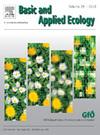Anthropogenic noise can decrease tomato reproductive success by hindering bumblebee-mediated pollination
IF 3.5
2区 环境科学与生态学
Q2 ECOLOGY
引用次数: 0
Abstract
Anthropogenic noise is a little-studied type of pollution that negatively affects the physiology, nervous function and development of insects. Thereby, it has the potential to disrupt even key ecological services such as pollination. Here, we investigate the effects of anthropogenic noise on the pollination success of tomatoes pollinated by Bombus terrestris, under controlled conditions. We hypothesised that bumblebees avoid flowers exposed to noise more than flowers in non-noisy environments, leading to less efficient pollination and lower fruit quality. Three treatments were applied to randomly chosen plants and flowers in polytunnels in Hungary: noisy (with played traffic noise and allowing bumblebees to access the flowers); and two non-noisy, one allowing bumblebees and one excluding them. The flowers were bagged with nets before anthesis to prevent bumblebee visits, opened/unbagged exclusively during treatment, and re-bagged for three more days post-treatment. We recorded the market value of the fruits and the number of seeds they produced. We found no significant differences in the market value of fruits among treatments, but the number of seeds was significantly lower in the noisy treatment, suggesting that anthropogenic noise has substantial effects on bumblebee-mediated pollination. Although these effects may be mitigated by habituation, loud external noise of various machines (e.g. irrigation systems) within polytunnels is still likely to contribute to the everyday noise exposure of bumblebees and could thus potentially lead to hidden economic losses in production. Therefore, further research is needed to understand the behavioural effects of both direct and indirect noise pollution on bumblebees.
人为噪音可以通过阻碍大黄蜂介导的授粉来降低番茄的繁殖成功率
人为噪声是一种很少被研究的污染类型,它对昆虫的生理、神经功能和发育产生负面影响。因此,它甚至有可能破坏关键的生态服务,如授粉。在控制条件下,研究了人为噪声对地蝽授粉番茄传粉成功率的影响。我们假设,相比于无噪音环境中的花朵,大黄蜂更会避开噪音环境中的花朵,从而导致授粉效率降低,果实质量降低。在匈牙利,对随机选择的植物和花进行了三种处理:嘈杂(播放交通噪音并允许大黄蜂接近花);两个不吵闹,一个允许大黄蜂进入,另一个不允许。花在开花前用网袋装以防止大黄蜂来访,在治疗期间只打开/打开袋子,并在治疗后再重新袋装三天。我们记录了水果的市场价值和它们产生的种子数量。结果显示,不同处理间果实的市场价值无显著差异,但噪音处理的种子数量显著减少,表明人为噪音对大黄蜂介导的授粉有实质性影响。虽然这些影响可以通过习惯化来减轻,但多管隧道内各种机器(例如灌溉系统)的巨大外部噪音仍然可能导致大黄蜂每天暴露在噪音中,从而可能导致生产中潜在的经济损失。因此,需要进一步的研究来了解直接和间接噪音污染对大黄蜂的行为影响。
本文章由计算机程序翻译,如有差异,请以英文原文为准。
求助全文
约1分钟内获得全文
求助全文
来源期刊

Basic and Applied Ecology
环境科学-生态学
CiteScore
6.90
自引率
5.30%
发文量
103
审稿时长
10.6 weeks
期刊介绍:
Basic and Applied Ecology provides a forum in which significant advances and ideas can be rapidly communicated to a wide audience. Basic and Applied Ecology publishes original contributions, perspectives and reviews from all areas of basic and applied ecology. Ecologists from all countries are invited to publish ecological research of international interest in its pages. There is no bias with regard to taxon or geographical area.
 求助内容:
求助内容: 应助结果提醒方式:
应助结果提醒方式:


